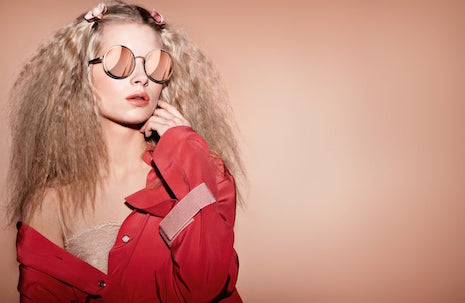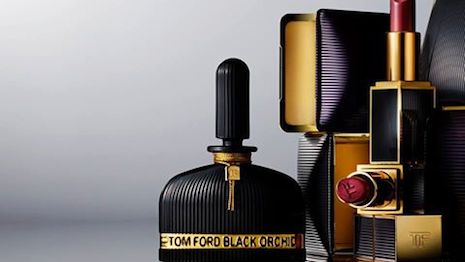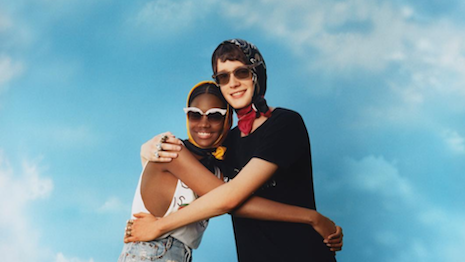With beauty and eyewear leading the way, licensing has become a lucrative business practice for luxury brands looking to extend product offerings without the associated costs of development.
Licensing agreements, where the brand is the licensor and the licensee is responsible for production, is much more effective than a luxury house attempting to balance product management, distribution and communications on its own. Although the practice is commonplace today, Christian Dior is considered one of the first luxury houses to leverage a licensing agreement when it began marketing stockings in the United States in the late 1940s through a third party.
“Beauty and the eyewear, as we know very well, represent the 'bottom line' in the assortment of the premium and luxury brands, as the result, the turnover and the purchasing power of these product groups is higher,” said Yana Bushmeleva, COO of Fashionbi, Milan.
“At the same time the brand that has a core business as women's apparel can diversify the business and enter the men's or kids wear market without attracting the external partners, just via expanding the power output of the company's assets,” she said.
“But for sure there is no economic sense for such company to build a new factory from zero just to launch its first fragrance. The eyewear and beauty products require their own know-how, production facilities and the specialists to create and produce the product.”
Fashionbi’s “Licensing in the fashion industry” report looked at the primary types of licensing agreements, the power players of each category and how luxury conglomerates take advantage of this profitable business strategy. Fashionbi also included a number of brand case studies in its report for context.
Made by
The categories most commonly associated with licensing are eyewear and cosmetics.
Eyewear, which includes corrective and sunglasses, is a $90 billion market that is expected to increase in value to hit $140 billion by 2020.
As a key pillar for the fashion industry, eyewear licenses are held mainly by five players: Luxottica, Safilo, Marcolin, Marchon and De Rigo. These licensees, with input from brand partners, design, develop, manufacture and distribute optical frames.
Luxottica’s portfolio includes Armani, Bulgari, Chanel, Prada and Valentino, among other well-known designer brands.

Chanel's eyewear is created by Italy's Luxottica. Image credit: Chanel
Safilo creates eyewear for Dior, Elie Saab, Jimmy Choo and Gucci. In 2020, Gucci will not renew its contract with Safilo, opting instead of produce its eyewear via its parent company Kering Group’s Kering Eyewear, a move that will likely harm the licensee’s profits (see story).
“My forecast is that big conglomerates will continue to concentrate the production and distribution processes and strengthen the control over the brands' operations and reputation,” Fashionbi’s Ms. Bushmeleva said.
“Kering is one of the leading fashion groups and in its portfolio the company has several brands, hence there is the reason and what is more important the possibilities, financial and human resources, of bringing the production of the key branded products in-house,” she said.
Smaller eyewear manufacturers Marcolin, Marchon and De Rigo produce eyewear for brands such as Balenciaga, Karl Lagerfeld and Lanvin.
Similarly, beauty licensees are responsible for the creation of color cosmetics, fragrance and skincare for brand partners. As with eyewear, luxury beauty is handled by a small group of licensees.
L’Oreal, for example, is the world’s largest cosmetics company, with 40 of its own brands and the license for YSL and Giorgio Armani beauty and Ralph Lauren fragrances.
Japan’s Shiseido creates fragrances for Elie Saab and previously was responsible for Jean-Paul Gaultier perfumes. In 2016, Shiseido entered an agreement with Dolce & Gabbana after the Italian fashion label refused to transfer its license after Procter & Gamble sold its Special Beauty Business to Coty (see story).
Others include Estee Lauder Cos. which holds the license for Tom Ford and Michael Kors fragrances and colored cosmetics. Tom Ford Beauty is forecasted to become a billion-dollar brand by 2020, demonstrating the strength of the category (see story).

Tom Ford color cosmetics and fragrances are developed by Estee Lauder Cos. Image credit: Tom Ford
Additional companies, with a focus on fragrance creation, include Coty, Inter Parfums, Puig, EuroItalia and Procter & Gamble.
As a whole, the beauty category is estimated to reach $675 billion by 2020, growing at a rate of 6.4 percent. Much of the category is not produced by the brands shown on the packaging, but rather through licensing agreements.
In the case of watches, fashion timepieces are produced by a sector manufacturer due to a deeper understanding of the industry and product.
For example, Richemont, which holds numerous watchmakers within its stable, has a joint venture instead of a license with Ralph Lauren to produce the brand’s timepieces and jewelry.
In regards to the typical licensing agreement, Fossil Group designs, manufactures and distributes Armani, Burberry, Marc Jacobs and Michael Kors’ timepieces, among others. Timex has similar partnerships with Versace and Salvatore Ferragamo.
While not as prevalent in the luxury sector, Fashionbi’s report highlights Italian fashion label Moschino’s use of non-fashion trademark licensing in its designs.
To create its signature looks inspired by pop culture icons, Moschino uses parody styles to avoid needing trademark permission, but has also used non-fashion licensing agreements for its use of famous characters.

Moschino's Jeremy Scott paid homage to SpongeBob on the runway in 2014. Image credit: Moschino
Moschino's SpongeBob SquarePants collaboration in 2017 and 2014, for instance, were created under a licensing agreement (see story), but its McDonalds collection was designed with no evidence of licensing under the guise of satire.
Pros and cons
Licensing agreements, as with any business practice, has both advantages and disadvantages.
According to Fashionbi’s report, advantages include sharing the risks and costs of business, earnings from the initial licensing fee and income from royalties and faster market penetration due to capabilities and resources of the licensee.
But, there are disadvantages that must be taken into consideration for brands. The main disadvantage of a licensing is a brand’s inability to enforce quality controls regarding production or distribution.
Although this is a concern for luxury brands, it is increasingly becoming an issue to the licensees themselves. Coty recently learned this firsthand when the brand tried to block a German distributor from selling its fragrances on Amazon (see story).
Other disadvantages include risks of trademark infringement and the potential for negative impact on the licensor’s reputation if the licensee receives bad press for its internal practices.
But, as Fashionbi’s Ms. Bushmeleva suggests, the benefits outweigh the risks of licensing.
“We can name three main reasons [for why these agreements succeed],” she said. “First sharing the know how and costs of the new business, second, earnings from the initial licensing fee and income from following royalties and faster market penetration due to capabilities and resources of the licensee.”
{"ct":"zpXLqB03lh+oWn+MEIP1VmSTMlq1dliIVmo\/hEakEXswWepxmzSlvM+Exhtm1sphtcvyZQ3aDxfs0iEtxEBRYvHEbaVM2QNoS3K4OG4+qy00as5Jxl\/CNNIcnyWgtAhOwlJDaMqjcLBUeymFNcdoO\/7vMgEP6BazuAnk4d7bC925WKvA55nzR6oQ8\/I5PT1HPnf8aTZv84tSR1DYhFLPlVGTnYNdNc99njMT9J1rGQ7Ro1qSHzvrkjv5mWw8uAEHJTeqZ0cvmP0syTFEvVG1gt7BOHr6ac6de6EaQRQIg3gz3QS3nRFy0RynsGZBRoZK\/dCnK3tHaZ6ZVxSvpu+j2hL3ab6nj83XHP6rueSN9DEEJMnJNCAJwFqQ1AgBUgVhVmOtBmPuu7Mun0qnVDtBthyhnWTSmXZx9MCICgXC6Vglx7U\/gOPZi1uK4J\/aZqabVvrlQJafy59QgzMnjJlaPBbNdaej8kGj87e+ZfyGLU0114b0Kk+itRgfp4OOjgtupaqSSbu\/Syak8WO1hyIcGRS\/P+Gi91P2Sg6o50lJacycTMKpmgEdKmir9ycrsLuh7bMz+g7vFzfPX25QUxVH7Wizb42w8MeVFXzBfumFV\/9Hin7SpxfYCij1AvoS73ZhyMq5QcLgq9kTsp96xmJ7ft6ApP4kKZU248Yke5izl3igXyYjY6TTQeAwSj\/rEVIZzsQ0tF\/viZPYIWT9IRY0sanD4So\/BaBXWV2eEVUp4my0jV8ipBYKKArhu1mrASfjtGKBpuEicFuRmJ4lFbr7WY0E8pVlS73GuBWtzgBfwBaOZp+VQ1wnwUUdsVPKT3RuN8cob0kRRUcl3tHDwYjMC\/b1HvN1ynCgVi5ZSx9aQdqtx+M14eiWCTuHFlYP75WOSbtCweQhuSxkG5aYCSNJYwg7QStU9O9acxJb4GghECJRatZfRWJ8aMr\/+pBcJ+IDQNyQTLymvoJ4YqEJJdK0+1jO1u\/xHT0W0cb643PMOb1WLm\/Bf\/7fzMjwElBwviiGn\/VAoiCJiaNFy1T8f+j7Y6qPORKIsSjB47yxQvU9IXEMuncjGygIOUG9StQ3JJ6HNHUvcXDgwHwBZrr5GBgWUIdh5GxEszwWsAfJbG2ZJqKl3IWJ2dLky6+TlByMll6pxGyyeqilr+BHW\/oHOvpnzQfmNrYUgqNd3YMXPtosfT11pdoIyWRjwwBQ7P+fLeVgmOzxd6rwC4xNImIZTnP89BeKMEkfLlD8FPC3Di0YyYYcH+7N6yOyu6MjSf0z+0fc1wDySjESAM61oYSsRhZ1aAPXL5MFMjCFqjHHu\/CXIH3qYKNGXe8cx85Qx927oOJ5peoXjExW3EIZyNJ3JorgRa3b6UqQwzsxbeDp7FiP87AFt2+6gYCSCHgvJsv1GU07wNatZFjiqJQwwluS5+qrLt88QiWvn38pu\/aWJikqeM0P4Mbt8YekRdKHSYkoYxQFvoyOYX\/C3EQQp9jinPNGx45BVOMmd8lq9JPSSdMo+S1W5HEwbLXvxwMywkqK25ViryouW2Y7IDzWlEiFmf\/P3FA0m2Gyq17Rupt8QpO2Epg5I1A+rrN6QRsPSHDbrFOdoYZFkzYqbfUC\/vE9I4GbEJZe3XlHEjK+wYSvt8Y51AxyTY9FVrF0vXMLHFxWQpwogjbdE1\/KeQScCb6sK4th5pVgWR\/V4wRvMIGxwelw75EhOBQFCirg7lFEIs7VXa\/RZe7s+k5gH8dxSrU1wWoyA49mvsIt3tftNCiu53XXSLc7UBfTcUW4FDpTW\/26xi8dI\/VH4mOa2kL68Gu4x5Sc6YM1HO2h2n3\/Ht65u0X+9TVeYCq6na8oX2Yg3w6ooh9a0t9yQbimQ0+nm9q0onSnR1v8vyIBohoRt3LhgKnuUkSGGjyigOCP0XGs4jswTwWoBv+U68\/k6DJhQAz06tyJK+Raz0bEtNCgXGu67GnAtnDC+2PZ6+zXmplfdwVxYIRkQIoudVCTn+rkV3n9t0RfHVqsj6ZFzftHK\/e379iZARhlMh24cD3ItZL\/G0QdrGdVUqu3y2GZINQrbnQ\/L8U6OhtypvesqYy9WSYiDsRFLSe\/iQPdrhB2pd456mWrehTfjGe1zRzfB33gRsxJ54707tLsUeUCysHYZLKpNKMhcLZf+5ZSb7ME2pdgNo2VRKT82Nz3RYm057b+I8yfxPLzRZUYJzWE7\/l0LFK6SvfWqFvXB7c1yhyndiNwe46g4I1k4lV6DieVfkkxKjQvMVjL0ZZD5e7sxzfeKm3bnBnbMF94MQiPYEQGcjH8kO4w6wXPOlXmrrq\/nv1uGe7Di5EPdeWnVq2H8dDCsW75qs1scXJEJ882FW9SkpmiGiDzwKmt6iSa2znbaUIqDuzans8LOiae+WrkEvBhdP0NkkIONUMMGfSkPspIvbsS50ah7BmU1F1YKIdGpY1fbNCU77fcf34HAMTurbdB3Isi0TgU2U6GKXyngzEUcPM1XtNtRdkLzU78x6WODSFIwGU6bVavnMGMaNYgJjb6GUsplpcva6ygH1q8Vzzydt2QyEn5Y3ohQxIoUaVrhXsmWaFpmx1mVq86RLumDWQFFNEwjaNPjPwlEI\/zqpQCEbwHsI3iVUJ4RGIAjiTw5gQGIuT+feqLyOy+iNxadNldJ0VzUC0+1QgD10YBxtEj+k\/zWXOs8StoQKjfrWec7DymJQnqjmxOnmsOQHbg8\/p2t4CLZn6jkHEdPDM4Z7dx2Nnv+pzZb0b2zDpuoNyC3iBG\/G5\/LZ095qNbCa9FcHhpBdht7XBk6jBQ9bGe2q9QSQbHhH76tpW8RbxzA+Rc6qPFr5+TdNZMW+YI0xmiADYOC3zFHweMuqNOoXtysrKAWuHCcHF8TuIKD6SsR8aX+OQ+17qixv40K1EKXENkKjVluL\/LIx9gDEBl9CUA9XUcjoJ+HzY6E881YkC+rV5eBW\/sgYOIPAOy2BOdf1+81lfoJ0eKZ\/\/O5znSMZcXpE0sXRYzzsZdAj56ThE6ULe8Xz6lgiGvOSN8NDsFKG+L6B+aAbS245i6VK4LMpq6ZfFVZZRXZ\/+NLm8ngtReeI6Xn+6Qt\/aqm0Bl8JFoJMTeyJpu4gQbCoqugfnaMlCNpmTpOiJsPOJTw4JHMD2YFeSoc2gNOmIGO\/bZOJ\/7kn+RGu46i+xvOHE8PEAIwzu5NIea1F4bWcMy8S34Ij6RQMM3aTnYAzF+uQFSOoCDCOTvkB+tokKE+VezZFLHFX7o+6FemQvmv5FfN0BOw3m9s5ERMCrZmHuC6iz4nnRbop0D090dHlc1LXdwnEnyHVd4VrB\/vh44g+U2puNpr7+A6rAspFmcaK2WWwcPvv7ln9l0\/B9shcX1wgfbycP\/qXmeUC5EKB2vz8EDjLKS8cUJt9vFXrvp4LEfoNcTEkOKAl3kFIXc\/NlhTuD6hHtV1LW4citvxN1KLkg5uR20B0oRSPcfusQcUgE1i5brb5hfd9X3nctWpRfwqClOb52ueCbnseXL8tUOAgfVDLKFqea8JoozBzOiYt0yR9ilCyhaU+ztRMWsl60B+09sgYZqdr\/LIC3Rh9+tT1pIrCj\/xJxJXhQdU20UbxFbsi1gbhuhM5MnTLV3hvb4FIYOn5U9D972VBeEklrzoMNXNtuIrHrsXnu6VkRnGaLjRUS31VkmpWMsCjZg\/nKC+88+6dR4gCG9pMBeS7CGZQ6fbPHVR\/KkbNQmW+172J1+U2Rjq4ZaSEZa+nePOleGUQaNHAmGzjH9V794J7zcjr0ziUNfuDhYqMftr3eH4\/BIHfe78VjQ+PCoRLQLPfj7GqzQLsIbk\/mhxRJKhCEv2JIL0DiL\/Wt11Ppa8xhpR0Iy0I2JBXEEnoXWmK12svG3OJsMRCtQsIBiVX6QQ+FBiRCn1t+RojEWmuxu9uajyy0Lslypewqfj7g+vvOtepcZOyAT8V8p\/kRSLz1G22J1XJC2HkQ5W9dUI8SUARTFQ8YHIfHklWiQilzcqcxpMpHRJM5U2kYFD9xVj3PViNRwTvkTIZcG6xR4lk5j3uW18CVC8B5zmcE191eq8dC52h4x4rIWU+XIeP55o7teK4MfGFn9MckhEcOZOwf1PcoINo8kcEnQHBft\/SWSCnV9cjTS+GofxB81vJ2AvU5+XsJt0kKImHHDwqg9hZrr1oxMqmjTK+gVHbRJSNHVhO3tMDn7iiQGmN7xi5WeSc9VQJ+8ywP6MaMu0pLMin4u42NsUHpjqV3Eu\/4eg2wVLMM77d9nJ4RoyW9YRG4mDhsLnWpB9DWjAXJLhHEUmeJVYeqqyAUO\/l5byNjYveH9L0Ihpk+Bx7Y\/FilTt9L54y3qm50xUOnuub\/apaUPLN8NB2AU\/pYi+IQylNLnASmWwFt\/bED2VkC97bcQQ5Au1Irak5AbwiKwtjsXElgxjVDlD9qQADfvkI2Ud9ZzovWM1CmAp31dpyKpeIcRq6ieF1PC\/7LokW7iVzMVZACHKgf1Cwvygy3mVbxciN\/Icp9wRIC72mm\/fLT\/Ep+1SQnRNofDWcMwg0y8KvuuoV4m4h4nh6azKn++aHR6pPSZdxQd8tat+EWK6z2HG5Qgpy8fh2pj\/8NpJfG0\/qsHTLscesT9+f2yF7vYB+jnJTR1kStnTCpbAxmXcY3NLP\/CFsPGWiR7NuO6kpD9VQu2aa+U1mvvRhx4XZjk+WeIWlvdjlWbRKj8VYdoT8BcU8\/GgOjehWSTqJM4yOkb\/VM6dawXyrCyHiGtp+pJtjHriYcMQRo6TIp4EoN9jFavLeHELpVycq5VRRLuK9D7DkNXWIaTi9SWhQ1paEpMQnx9SJdJ7UibrwnA4Uvt7FIz\/90Dd6s75jcPAMNCmv1bYRWvm0Tt0zGaHBdTP6FJKZ9FUx2LQQtUc1qfmz79ZdPmYPu5nSVMMZBFNA0HBJjimgmSwCh\/znDWJ17XOkxmYMM\/xDo7kF82OmJs4vNo\/3GdnzTGa3PlbwfYP4W1Ep+OU2p9E6GM53QLh3vrz97bF34DAgkpMKOzhda4NJ\/N6OfTV\/IIhqZfR57dJN4MJ3vSmgw5FvplSm9naJEhrWZJ9DNqPkOSoDj115\/sQGGf0MHtGnzgMKpyw0OLE5zuxvxAgSog6og6Z\/4WHTbJzlX0qqPZE2\/AZc1Uj3vZI6yDOQIV2kwW4P3ewHgR4IwBqLRfi3J8VDmtofWk8eE3hitv66JGGJazwi0NFqUq3i+V9gkydVnILWKkXOV7kVtT8r5vUrwGXUA6cw9cYeaYSThT\/bojnjz703Y1wunUSFqZ8N9IUYyWZELK+MWtET6Bxd9iKFav5SMQwMSUkh6y6zJjZJCBEhq9ZHnaLrCu0\/ldLpT6edBdoXDv\/OuRBhaEeQj3+EoACzXBtBx0b8frylGuC3y9wGqfnGMPsoYATYbv9CTrDQU4GLCnym9dFydFWgBwB6D\/hIIA5HdIu\/y3CWMM61pUusaH+KBC+JEiLED0BraR29TBm3NUdEiKJ2wB81iKpK1uf3hRpeNLIZ6yZzH7uwN\/T1lZExt\/eqOGvd3OLAnI9V+dYGKbOaFMB\/0ShrvoPth8QG+b7w+sLuNtCiW9kk6jv2W6iHFh+ssK8YmxRzSWc1sT6QIiKpneORkKiyzAHdRZYIX+0IAJIGul\/kBP9ZgAkwOKRcpvbShGgwC6n2s4BJhM1fVO\/ABkZboiblAjPjWxWUNmPMf7wOevTvJ8JT1pfFuOm6ikRGl5uZvOa6rQj6+7ji+R5dIhBieZmqmDQZxDvkoYCy+f2lVKzQNL\/cwHN7v2wrlfkkaupBLgSuohX7AcB8ahfPDVDDjpLe4YRDNXHU4P8EQRZ0LIaDneQNvE1ewCKlKYNGJoSgUwSAICcv5UpyxThPkmT95bboXe6Gmp5q2qDdE\/2eAp2iaPZFx12H2e8rh28Cvd68zxSAAosKHaYmcwDnTzBH+VkOiBoXijjbMcAfMEy2k\/FmfKzbbpOJlTFieLLWZ+\/5ubnAkEHBUPBE\/D377OaioecsnSbnPCxgmTU+EwALCsUXxLiZPCcU4qgT4FnsR9UTdTpyqvt4x4reulakTgDmdG5Wqra+n95Q+Baasi4aw761uPQ5DKJtQIZch0YJQzBkXZQCycWd8vVAqREM9qikai+\/s+4UgPf1eCGKKf0bFY\/ByEtr\/WYIxFOI9fL6EmAtx0AexwseS5TAx25gMW6Cz74dBmtMAi1kxd9MdG8LG34SCd+BjX5dvBj\/BwFJPAOllIcZCGBV0binagwKsOCzP4YuG\/pZ8jf6jaItL4recVXa73Fz8Ox8lg9wQjgQI2PVPNdwfTSyeakQfpmFP23MiNN9sK7Lu+wOmib29FZZ2fwCOhC\/8gs2A4BpljGzgFP\/n6+Hc7VQ1cvYAD3ZRhAdJxT99PLNKoTC7O0kVE6HSTFRP9gCkZLJ9vdoGSsvVdn42Etb50d3YK+GpwkSaSrivgm3I0CUKpkmJDJNFj7E49IBWmEAtt9+XghJXajJ6Cla0dhC83Bmw3adPY4ZAUe7BF+YEM2KCQWZ7KJJZQHKOMBk7QwGGoB+VUN6TSxfbbzYAFMjJusj63rrIlsKS7rToP+Q9nXm0pIIynp\/Y9mODcIS99FB7MDJumOgDSrmEN7saYMrWR+3td33pNrBliCNIj3U6MvdNB+6GS7I+jS1v\/tm0le7tN3\/MjKMPMhTwEUC+LqbizmZMNIVkIE0eqCPe6JFBLjKkyEXHQapkDa8f69mTAeM+XeUYsd9uKNQA8xoPAYmTgzXufE2xLiAM4ptzwM8NrAeeQ83zSKn7LmIo+4h+vWW7EwH2J2SQaUfSc+EnERLbvYxJtxsAGgBM8CDchTGKp+KWMoE51mm+Bh2rvVYdYb\/Psq0R6fspLH+lw9TeitVQB0ccPadr86Mdud\/SLVO4gKv66o\/riIAQF0zt38dxpvQOi3KvSVtCqTQGdSTCNLouPdh4BbU+QoiROIhKUzPZSzmK9Wnpax2qz5epa75N3vdc9fF7hQ34Mj2+yMci0PPOC17i7C5L7chGOXTbath7F7o1yH\/NouXVnNN03BvKbKmKso1rEKffqdFkXRgpH0v3Q0HH8IZlHTj\/CscJqpkl3b9MB9fLqUK9RxUViT9JsKvlzUn82PakLOPpJLARnqkFEn7+XHx+XxUT\/2EZTYCkPhvzS1YY+mx\/R6aC+q8eMSf+c8K\/KfVrxHKEArmFbqQBQkf880yolzCQPSlCEdpSrnIgpxlLo\/34SNPQksJuMS\/QjZi6qdtJlw9BTHa4Zu9MoX8GGZ+wGV2zXL6ICCVF89VrrfBd\/f8Hr0sf2znkWUXRgQP7qXiTWUFtDqTVPr\/NlD313ng2bpbnEWu53ydInugDQ0t9tP3txU4\/H0Pw27RINad3z7E8lSzTz0ZuY\/DshiNusF2uQb8yImFKn4oKQ6RqBA16HnvfQ1Rl9qOzsbFqGP6nrueqvsIbu8NtO\/ztOZ7GkoNvt0Hm2Jsx\/BiV38pFTyOqIJ97tgQrUIn3a7DZtkoxeL0xN0sNGrK2cTXgBsfXzOUKGeYzb1CkSF73s2TEqjSbFso9T8qfVHGZ3HNBXwXhWfGF1XSWD340WKKxPdB7gl5bGRvKQDxk3OkqRVPFGvuvMq2vDWDLdfIFS3ho+xxVLSGKUlcdHg7gMyuONukIvlDXxhRE22mof80Y3G7+QnHpzSGFKzlV+kfpuRTprt7EUURJiM4MslDt6cqKVWI7Ui61Wd345QUMA0yBqD9+7iT9bmStYh0AbUzvCSmXA7lg9M6XM17ZafDJhBjutnaBq0uniuNa9d3fiCENK+vSlIG6Etz24NfNnDL8jYyVAYF6\/fbOVDTlPUqhOcC8zhr55zwn1C0XI9Yx9M9qHVp3qBOKQcj5V2AXMfpEJVXcQyeL9q7cm3JjAKzJc9WlmoIEWskbDbpw8t8yDgYwnbeUs3QZApZHJNCcGrgEbTmCecjQQbP213VZvoDS2W2giQrWah\/dHbrBBEEYqTqVspvSsu7U1KS\/hy5kkCr124PnKCO8W+BGKiA9K2mYS\/AedjGHyp7YTvVyacNVVlrFhzDT2psapb8cquzInuDquj1x0XG9FetECSamZIimnAAL5BYde2kmA4h5BXs4j9d6Kug4IXsadS5ToB46eXOKFw0FJAdomVv+aeOaHoShlrZbnySRzc4fAY1AK8cavYapoGaen6jousb0Hnlu0Fo6LSKlF6WCh0LMJY\/9cz97CXUF48AV+Kepsx0qii3IJA6PrsxOvrDUnZquMHcZt\/FXZGrKxvazX0+uLd1IlrRZi5L6+tDMM\/xdmcanKoM07TyqEAj0PCXXUIejBjfawXB3tVMVN4LsnciRnC2O0951ZBlJvaUBymlvTXPnMYllZX6Pea8QvIjePbQivVWqhacMr+eY8oh2\/e62W50ZCqNCI3Z4wTHRHnTk6ZC7RxiRFqV9J4GUzRBxPcJBHz3NKWn+ySsYgU9Ni8R0clWB8pRPBO6kAVGvAInfZltG5\/C\/1Z8+\/BKsLP2U5ga0af3p4DzSv6jw\/iPMOeF+r6dr\/JLonC424TGN4V5E5hPHMkwrbeZGzs5+CS7QNQeIbddeWlNquxpS+2ToGOyZQmWHtACXNlMxZZQp2M1kOjMZrcsnEMR7zM1j\/jfawQsVrZbBTgj4HPwBf39sDyv3T+L3VVIqbt4csyC7tR8VBuwpgmDelnNvM4Wwu9Wg3TSoEOEfGmEKZqK0o1qSaeuiKpJT25oVlkR9r0SJ9Qiy+ySrwmvwAmsk7rd+REUiSby1eZDoqnfuId+jRKbbwTh0scRUpvPGVH6AYxPE+cyridz5fs+Lhe6pwb+4TFgqx7FrtntkMhyrPmWHGAVXnZSZcIbvoU+1STHcDzy+yYYmRlrvafNOyqMVXoFxtBJzx2Zm1BLWexELbtDRpiDWeOF\/x+b\/Y+6YPizxELA0zOjaAuSEgnq3uDerpW5OI9Yvd5lzm+Zm+GedIHRyA1m3frwEfEmVpb7sx0Dvr6yThSKv+Hz9kUgPT\/j8dmqEk99oHLzjgMyiUlbJJmdzzq6LPZ5nr1Pteo6epMWMhKUr4AnN+zKlxdUuwPmcmQznJC+nHew0dH9H1xz3jz29f2bX5ptRsUR2YrRk5ChIDFrJYdbm3Vmuf156fvL0E4EHpSBtCII7G7FBXR6zW+hFgoQyqezB+i3dZvo8XvhvZMmuytz+aORdlHNyt3DqLkmzqnETsIMteIhO1DUlMlZ9qgnHArWloyzz5wsNWd5efnwJG7tUGsEufMi0HQ5lURXIH3csDVGLLv7CR7jrC51h\/WxzdfH0ekNaa7VsFpg85rBCnenb4cYao7rECl6hJvn08UxDQCCdsNypFeoDnyp1Avr59C12sRk7unT3sS6ndwFImLfqQ4aUx6dOl3bu5VYFPBCpzmhXJvlRIFA4vn4J5AsU7yo6n0jhEgj3tXu8iYcCXO7jTUBOV9gEfOHid5FbXzTAFqNB5u5LY0Jj8EJRjBtxdB+vNGh+ElD8N3lWXg0gHos1fl+13Y4kFS0rjR3O2HDhJSFwk0eMRNqs+pHKBLMJtzG7LpCx7qApSHe9A6zEkyo\/bw5H3XWXLGPUyLdf3JOD6VOGHD0JRoS3eRjQn60R4uHScDRyyB1SyNoSjX2IbgNXSfezBnlE7utFBlpXQn\/PmlrzKyYUVNB0gBkEYQf7XeMPsPvEgYB8t+rNQy0AtibVdh+6rQqJ00il6nHuYl2RSyaMNxuIUlPjMDLkJNks16f3Zaf+t8tUTYX+2BmwIH2tGvF+T4NhN+HZLrc+f75Pbc8xpOEDiFLqV4WrneJxzOjsL1OHIUEN9iWTmz0Q8LHYGqcM5uH\/iB4tITofl\/wCHL1A4Bb2J73KgWrm7YD\/LIPYYdHplaMEqS3TjpherF6lE5n9IPoCPf\/CDWwv7h66fW5ZLkmWVxezdD31O7QbHf8zN7EcwzSbm+1rsEzlRpV+TyZbBi+QBPSg5MJmehaAFNnScy4nPiec69DzoCYmfKUR++cTRvPkwZ4d\/V1p7NaDyUQ1GJ\/\/mUjWX7XvqN7J08ZBRadnIB0iqSEAeZUw5N9f1\/8SOsoQRbX61Sr+o06FCY5WSofyjLKGZ9Dby7776tJVd7RGdPgmMRPZesNJb4O1QzgvmJKE6RmftM\/WK8zK+zq0EjgE72pfe0Fzw24iRjQWwTQ35YqwFxc5ScDUNSL9+ZHC4q6hg5VKq\/5G7YSavj+Ka95gJIGg7MpkwwiCLUwuh1tfiMhNrrnnbvrRbbmHc4Q\/Q+B7biGplXX47sEizh5NuegQOGvre\/A7Mrb9Zs\/i0YQX3gyBWZBEJRBVACPP3zV9\/nXtqhuXKTULTqkhlbA1F3b33rX7tNQrnz7LVTNOh8g7K96yGZvNSGDA0mWrPhib6MTxtBH1Gp0FDClOngCYTRNGRhCZYfIVYB0k8xM\/\/Afuo\/tiUa7g4Cuyf09V4cOCtJbiZwTu3JALvpzKLWZy7KoR9l\/ZJeSHSZ5FOkhgJkxFAkpXD3wh7nufu+lWik1PNcyUaEakp8DXEduuG7SfI5ZePiDr3mHshaKzABf+mHYQz5s3HwDu2YPx2im4\/\/\/vACqvzdQmURclSZ4zJUqL2E9rUoswCQcTiW8Xr+WCvYE64fPYSSATGIqt76gY3ZdC8AKoIDIDq64Eon5CjNM3pRuv\/nte96UGr4SdBaLG5BbXFr541WmIL4K0q5k92\/Z0yRDGqX+QespEtlZP1iOillUi6IjL\/kYKS5lQzdP8R0IHaMp1bjl8wHbfIFxqOFcIvUlHq3C030M9zVJceeOm8SaDQwN2ocQIOYAcv5WkTkZANcIfSfoZRt1SZJQn2u1xi7WjmFkSZB0+pQUFcsh2enbjcM+7df3SUY94TUojp6n3C0cmF6PK1nNPGL0QrYqUJ5xQhZ1uYMjw4qXtw9yN4XJi+TO544wGPG1niqYIy8kMHCCkUx11vcWgbtk0zfIlnn1pXo6dKkRtttOmSNsWEBgIlmZjCRaGj1rTK417o3isNQbcm8cL1Lkj\/X5Qt4SuiuUJ6\/X8erZekRTd0DazWO7UQ70vfg0X3nUYDbppoGa2OpsaajeNySxruYEc5tTXifU9SGC2jhRebXmnhO3l7FZaWG3K4bPG7A2lF+lAnW9StxVsQzLU8cXc3UuoFSBNooYrOHHfr0hMy3oc541RV+VsifyMLR1\/Vj519qf20IQ27B0Q6UFedL99uNHnGGu8qQBEonCd5w5Kty0a9aYA7A9JDQHY5dPuNydcuiSp8ULIQbnXoYNV89BNHy9XHFO87CGq5\/E9+rKzkg5OpUhV7+\/+64QmUfm2QkLtu2HtoKq7hzWZknfJDfiBCyC0J5i9Bm+WY\/NsvMMCK4gqCMWKShhNu7wD9xx+qkjIhsbKck6\/yRfBNX3vlihwmddqahKJ+wi6Bm8Z7H1wDNWdBe75N9Ytyw1Cxh5LGT\/gJUZMPTXdpgk0NQ+sF2j2UEVt2FVQIgAXiT\/l+WKitxiY5I6fNkQHRZ7qcO3Ov\/lUTmphFWdLIlPvQwgZt6ikjGMiUr1gAHQRfzIphcL27XA\/NXu2vOzSB32TDs5whBwUqkmPnTMZVhqVKkZsX8+YSH2tNnFflJ+wYPlEeDqQmp63RTdo2Mb5b+KCw3CYl2jPY4txnIYFNldksxQd89XEV7qmXVDzfrzafhYpGZWmvVHAmBmpxXy7JdVHhh3+Grxz7mP5h9UtDB9bQSSteg8uD+7fZW073qMaK5iiC0+pEtZ2TT2lhnlFI+\/JJ12g649AFm\/T7XqLyF4+ZboLtjqvzXrSO1tMfgh9hNQ1ZqrLOFCU2cT7eutZWeBWxd7EeqAvxH+ouwmW8bqoM1UDXNtKFH2+b6OLsqoUWgVcrEfDLJD0IY\/UYtU2M3yASYuSRPwnDxMdfA+zqcE4obp2gMOA7ONSU9JkzRcloX6VjaTvopJo7mBvlCV8\/0TPNX\/5O5rUd22q0H\/O15DK6JPs9PrF0UVF+8ClXuwPCBeZX6b4nyweOBNaGWvweKpMMPw6pGPnQWSYp1r+JRVdIQppDmCf4cSxg9RU4kkuUBvD9s3+XWvvnR9N2EbjGiUbe+T5qMHrbipcbNO+TLgCozPKzzPy\/QpAe8zFfp7RC2i8fCOPuYN0YNgtzfp9zNn9Uqb+eDJ\/gQjbqGeKaVNvAYL5X8VTohXjXhHioLU31kbWmdQ4pLDWXTlVEUll\/M2S8owrlxhfA5tSwS1gBu0BdBVWRMWGxnaJoyaowplT\/H5yWcGsBaMtyC+7LU9p+2Jw7ztaTs\/T5uiSaC9ofuCBrQX+fFncxlkQSZ2OoEoHJlOIPNwjJL0gqojVMid9PxX6aKsois3ZQcXYIRZdLLpeLpYjv\/HC6uUGyt9UG4K+qXKVvntDAaSFvoxLBdRShmvlDLlo2OdVMCYschtZ+v31kKEKiZ3Ba6NyAmZT\/L4yZ0fJ43ATOeG9uIEXm2eciDmW5Dz2tZlJtwOX7hIMMcWRAtHWw\/41CzEtl0p2xiVeRKnD0W1vhkVe4fBAnwAbaDOIDx9lpLjt\/DiW1eeQhTlEo2hcCBtpfFNENvPwfwHS55uSziSQzcvPHrR5f90NBQfyJOhx\/Wr1jksufVGP1IEtk\/E1QmldpxIhOClj7KMGYAwDkgsUtIYnWTEc5kVjhVqA9rkdePTbjXQTFGAMTaeTwMVn5MNVn1NdVHru5mkIPHaFcQofNUZqx5UwoEBJhsVguwl2vt\/R+IZbTRfivobEQtMPGyI5Arnaoq3YE7W5bvBkHw4uu3N4JYuNyBuHwgFQEGomT6r63bmEQqaJi+ekLH1jFB8bOIUrrsgc6O8I7MCnhWDnSxYu7aRp1RtcbEpopIgfrKSGSTBft8XS4DyNUvBBK53j3dVKYyDnBdC6tXFHiWb23QxYELAEEIRVclEBq8j8Q8WyJysUx5TDvwOcz+YT9GTqgKkgcvWgHsvxp1IHVyNtl6kc43dtc9Gyj9dEzuwmrqT9rb1UHJ4u0u25RwyN+dbVjTGsOX0gVhdKvgnJJFEMotOB\/rezTSMS9Ro1mabQLMcYxrAq0YuHx4PWjgY03XsjIDgq7kqRV8dq95dpKAje53\/sKDBRpGUu0Drs4Q8Aj","iv":"c0700da93a394c4dc3b718c7bf895912","s":"9ed9953e9f9037c2"}

 Gucci will bring its eyewear in-house to Kering Eyewear in 2020 after a long-term license with Safilo. Image credit: Gucci
Gucci will bring its eyewear in-house to Kering Eyewear in 2020 after a long-term license with Safilo. Image credit: Gucci